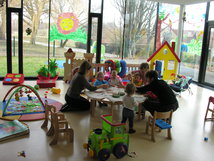Social inclusion
Concrete examples of projects
The field of social inclusion includes various fields of intervention for cross-border actors: improving employability (Pami45+na +link to employment factsheet), access to affordable, sustainable and quality health care (health factsheet link + Cerdagne Hospital) and social services of public interest (link to cross-border childcare centre project), the integration of marginalised communities, promoting the social economy and social enterprises as well as local development strategies.
Cooperation enables the improvement of social services, including their accessibility. A cross-border hospital such as the Cerdagne Hospital on the Franco-Spanish border can receive both French and Spanish patients and consequently improves access to emergency services in this geographically isolated area.
By pooling financial resources, the quality and capacity of health and social welfare infrastructure can be enhanced. Various projects have also been undertaken to improve access to public spaces for people with disabilities (Accessi Tourisme, Perla, Montagne pour tous projects), schemes that are in general particularly costly.
Cross-border cooperation can also be employed in the assistance of the elderly, or more generally in the field of human services, as is the case in the Franco-Italian project A casa / Chez soi.
On the Franco-German border, the concept of the “Second chance school” has been adapted to the cross-border context, giving young people between the ages of 16 and 25, having come out of the education system without any qualifications, the get tailored teaching for basic and vocational skills, targeted specifically at getting a job (Franco-German cross-border Second Chance School).
Also on the Franco-German border, there are several examples of cross-border nurseries: the PAMINA cross-border network of nurseries (Interreg 3A project), and the bilingual nursery projects within the Strasbourg-Ortenau Eurodistrict and the SaarMoselle Eurodistrict .
The exchange of best practices, rather than a cross-border competition between social services, can also improve social inclusion within a territory through the exchange of experience and methods. For example, the Luxembourg territory is less experienced in the management of unemployment than the French border territory. The exchange of methods and practices in this field would be beneficial to Luxembourg, while Luxembourg could enrich the fields of research, development and employment on the French side.
The SAM-E project (Service-Activation-Mobility Eurometropolis) in the Lille-Kortrijk-Tournai Eurometropolis, is an example of promoting equal opportunities in the field of professional integration. The project encourages exchanges between actors in social services on the French and Belgian sides of the border.
For the integration of marginalised communities such as Traveller communities, cross-border cooperation offers an advantage for handling this complex issue that transcends borders, by avoiding its relocation and privileging a cross-border resolution.
It is public authorities that drive social policy and promote support for social enterprise. In this role, local authorities can stimulate cross-border cooperation in the social field. They can anticipate many social problems and adapt to the requirements of the local population (Proage project).


